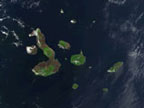  Galapagos Islands Facts Galapagos Islands Facts
Enjoy our fun Galapagos Islands facts for kids. Understand what makes these Islands so special with our range of interesting information and trivia. Learn about the amazing and unique animals, birds and creatures that live in the islands, where the Galapagos Islands are, how Charles Darwin's visit to the islands helped evolutionary thought and much more. | | |
The Galapagos Islands are located in the Pacific Ocean, 926 km (575 mi) west of Ecuador, South America, and are an offshore territory of Ecuador.
The Archipelago group consists of 7,880 km² (3,040 mi²) of land spread over 45,000 km² (17,000 mi²) of ocean.
The group consists of 18 main islands, 3 smaller islands, and 107 islets or rocks. The largest of the islands is Isabela which makes up nearly three-quarters of the total land area of the Galapagos islands at 5,827 km² (2,250 mi²).
The islands sit above the Galapagos hotspot where the Earth's crust is being melted from below by a mantle plume, which creates volcanoes. The oldest of the islands, more then 4 million years old, are slowly disappearing back below sea level. The youngest islands Isabela and Fernandina are still in the process of being formed with 13 volcanic eruptions in the archipelago over the last 100 years.
Five ocean currents converge at the Galapagos islands. The Equatorial, Cromwell, Humboldt, and Panama currents create variable water temperatures and unpredictable tides in the area resulting in a unique marine ecology.
Charles Darwin famously visited the Galapagos islands for 5 weeks in 1835 on the ship HMS Beagle. During his observations and collections he noted that mockingbirds, Darwin finches and tortoises differed over the various islands. These facts contributed to the development of Darwin's theory of evolution by natural selection presented in his book 'The Origin of Species'.
Due to the uniqueness of the islands and ocean waters there are vast numbers of endemic species including: Galapagos land iguanas, marine iguana (the only iguana that feed in the sea), sea cucumbers, flightless cormorant, blue-footed booby, Galapagos mockingbirds, Galapagos Penguin, Galapagos sea lions, Galapagos hawk, great Frigatebird, waved Albatross, and over 50 species of fish.
Unfortunately, whalers and fur-seal traders in the 18th-19th centuries killed and captured thousands of the Galapagos tortoises to extract their fat. Because they can survive for months without food or water the tortoises could be kept on board ships as a means of providing of fresh protein. Some entire species of tortoises were lost to this practise and others were on the verge of extinction. The most famous resident of the Galapagos islands was Lonesome George, who was the only surviving giant Pinta Island tortoise left on Earth. He was known as the rarest creature in the world and served as a symbol for conservation. Lonesome George died on the 24th June 2012 at the age of 100.
| 
|
|